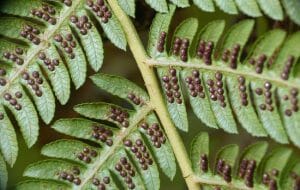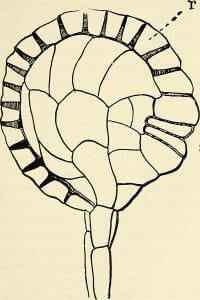Sporangium Definition
A sporangium (plural: sporangia) is the capsule structure belonging to many plants and fungi, in which the reproductive spores are produced and stored.
All land plants undergo an alteration of generations to reproduce; the sporangium is borne upon the sporophyte, which is the asexual second generation structure.
The majority of sporangia produce haploid spores through meiosis, although some are able to produce spores through mitosis.
Typically, the plants which develop two types of gametophyte do so within separate microsporangia and megasporangia. These produce microspores and megaspores, which are functionally equivalent to the male (micro-) and female (mega-) gametes. The term used to describe this trait is heterosporous, and it applies to some bryophytes (non-vascular plants, including liverworts, hornworts and mosses), some lycophytes (lesser clubmosses, spikemosses and quillworts), a few pteridophytes (ferns) and the seed-bearing spermatophytes (angiosperms and cycads). In some cases, both types of spore are produced within the same sporangium.
On the other hand, equisetophytes (horsetails) and most bryophytes are homosporous; they produce only one type of spore within the sporangia, which subsequently develops into a monoecious gametophyte, possessing both male and female organs.
Sporangia can be found at the tips or along the sides of stems or leaves. In the case of fungi, the sporangia are usually found at the tips of the hyphae.
The sac containing the spores is often elevated by a long stalk called a ‘sporangiophore’, and is supported by a non-reproductive structure, which extends into the sporangium called the ‘columella’. In fungi, the fungus may produce the columella, or it can be formed of a material produced by the host on which the fungus is growing.

The image shows the terminal sporangia found at the end of the long sporangiophore called the ‘seta’ in a moss species
In the ferns, the sporangia are clustered into dense aggregations called ‘sori’, which appear as round dots on the under side of the fronds. Conversely, the sporangia of the lycophytes are on the upper side of the leaves or along the stems.

The image shows the sori of a fern. Each of the round dots contains multiple sporangia.
The microsporangia of the angiosperms (flowering plants) develop within the anther of the stamen. The microspores produced within the microsporangia—of which there is typically four per anther—eventually develop into pollen grains.
The Launching Fern Sporangia
Because plants are sessile, the process of reproducing can be problematic when it comes to reaching other plants with which to breed. Rather than moving themselves, they have evolved to use methods which disperse the spores or pollen away from the parent plant.
In a large group of ferns called the leprosporangiate ferns, the sporangia of ferns have developed a catapult system to ensure their wide dispersal.
The sporangium of the fern has a ring of cuboid-shaped cells around the outside called the ‘annulus’’; each of the cells is filled with water, which is lost to evaporation when the environment is dry. The loss of water causes the cells to shrink as the volume inside the cell decreases.
As the row of cells shrinks, the annulus is forced to slowly move into a backbend and straighten out in the opposite direction—similar to how one side of an accordion moves as the musician compresses the other side.
The change in the curvature of the annulus causes the sporangium to open at the ‘stomium’ and the spores become exposed.

The image shows a diagram of the leptosporangiate sporangium. The row of cells around the top and left is the annulus, the two longer cells on the right form the stomium, and the spores are in the center.
The negative pressure (approximately –9MPa to –20MPa) resulting from the loss of water in the cells causes ‘cavitation’, whereby a bubble is formed within each of the cells. The generation of the internal cavity creates a sudden increase in the volume of the cell and the annulus springs back to about 30-40% of its preliminary position in 10 microseconds, propelling the spores as it does so—this is possibly the fastest motion made in the shortest time ever recorded in plants. The annulus then completes the cycle over the next few hundred milliseconds, making a full return to its original shape.
The sophisticated method of spore dispersal is commonly compared to the action used in the functioning of medieval catapults.
Quiz
1. What is the term used to describe plants that produce only one type of spore?
A. Homosporous
B. Eusporangiate
C. Heterosporous
D. Microsporangia
2. What is the role of the columella?
A. To support the sporangium.
B. To grow the spores.
C. To propel the spores.
D. To support the sporangiophore.
3. What does the negative pressure inside annulus cells cause?
A. A backbend of the annulus.
B. The cells to shrink.
C. The stomium to open.
D. Cavitation of the cells.
References
- Forterre, Y. (2013) Slow, fast and furious: understanding the physics of plant movements. Journal of Experimental Botany. 64:15. Pp.4745-4760
- Rost, T. Barbour, M. Stocking, R. Murphy, T (2006) Plant Biology (2nd Edition). Thompson Brooks/Cole
